Are you terrified of big, scary dinosaurs from films such as Jurassic Park? Well, The Good Dinosaur will change that perception. In a world where dinosaurs never became extinct, a timid and friendly dinosaur named Arlo lives on a family farm. This story follows the conventional trope of a young boy who embarks on a journey of self-discovery in order to ‘make his mark’ and make his family proud. Through having this character as a dinosaur, this film subverts human-animal relations by positioning him as human-like alongside the human character Spot that he meets who is characterised as a dog. In doing so, this film sparks familiar questions surrounding the morality of our treatment of animals in the real world and individualism of animals. However, this film is unique in its presentation of these ideas as through subverting the roles in the human-animal relationship our perceptions are challenged in favour of moral treatment of animals.
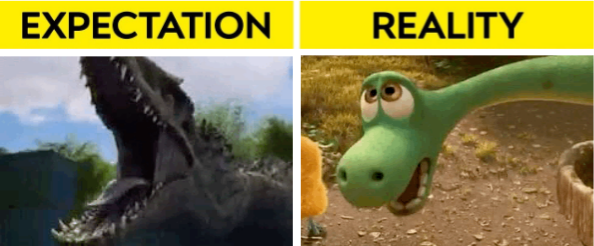
This animated children’s film has the major genres of coming-of-age and adventure. When taking these genres into account, it is apparent that the formal aspects of film such as mise-en-scene, characterisation, shots and sound have been tailored to reflect ideas surrounding human-animal relationships in a way that is imaginative and appealing to a young audience. Through using the animation format, this film is able to subvert the traditional roles of human-animal relationships by giving the dinosaur Arlo the role of a human owner alongside Spot the primitive human. This is because this format is recognisable as separate from reality and is creative enough for the audience not to question the choices made with respect to characterisation. As dinosaurs are extinct historical creatures, diverse interpretations of them (such as Arlo being timid and human-like) are more easily accepted by a young audience as they cannot be questioned by experience with the animal in the real world.
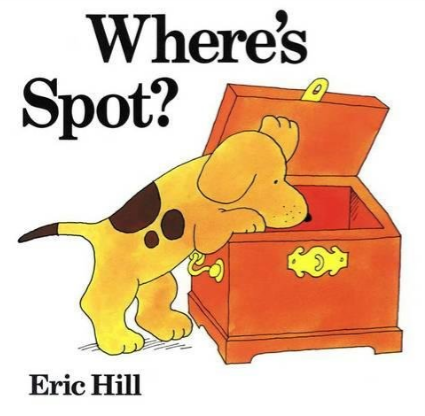
Spot is characterised as being a friendly pet through his dog characteristics (such as crawling on all four legs, panting and barking) and his name being associated with pets from families such as through the popular children’s book series about Spot the dog. Therefore, he is familiarised instantly with a young audience. However, Spot is presented as being a more diverse pet than is initially assumed as he transforms from his address of ‘critter’ to his personal name ‘Spot’. During this process it becomes apparent that he is an animal who can protect his owner, understand emotions, be loyal, and help Arlo fulfill his journey to becoming fearless.
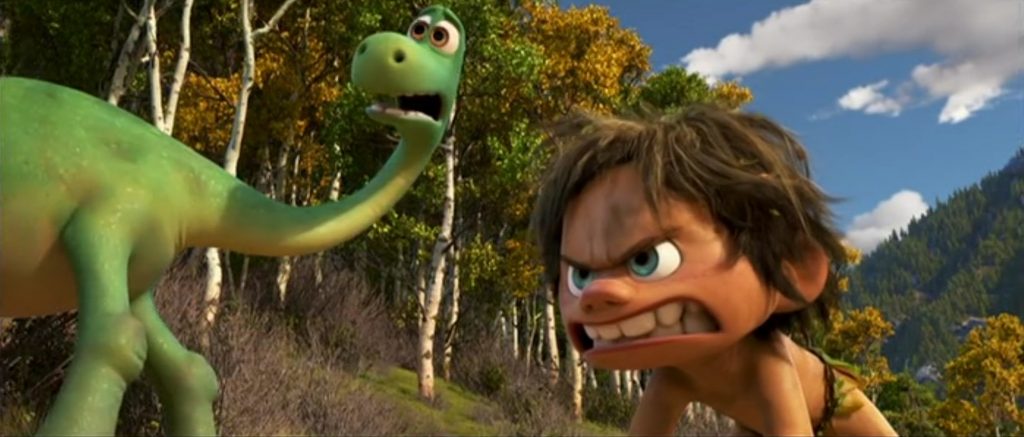
The human-animal relationship of pet-keeping is prominently depicted through the scene in which Spot acts like a guard dog who protects Arlo from the dangerous snake. As depicted in the two-shot above, Spot is positioned at the forefront of the screen in a still shot to allow for the audience to see his aggressive facial expression which embodies a dog who is ready to attack. Arlo’s reaction is captured behind him to express his fear and emphasise the threat of the venomous predator.
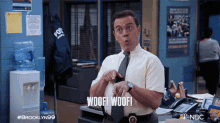
By having these canine characteristics, Spot embodies the term ‘zoomorphism’ (attributing animal qualities and behaviours to a human) as his zoomorphic representation allows for the audience to recognise him as a dog and therefore understand the subverted human-animal relationship in this film.
During the fight between Spot and the snake, the regular slow transition between shots which appears throughout the film changes to quick cuts and the usually slow and quiet extra-diegetic music in the soundtrack rapidly speeds up to reflect the conflict between them. Additionally, the intra-diegetic growling from Spot reflects his hostility towards the snake who has attempted to attack Arlo. This growling contrasts with Arlo’s speech which is merely a gasp and yelling in fear, highlighting his characteristic fright at most situations. These human expressions which feature alongside Arlo’s spoken language prove how he is anthropomorphic (the attribution of human characteristics and mannerisms to animals) and thus is recognised as the pet owner in the relationship.
By contrasting the sounds of Spot and Arlo which are within the story-world, the braveness of Spot is foregrounded and he shows a willingness to protect Arlo in a life-threatening situation, with Arlo appearing cowardly. Through having Spot as the protector of the pair, the film challenges stereotypes surrounding dinosaurs being terrifying predators as it is the dog-like human boy who fights off enemies as opposed to the dinosaur. In doing so, the film more generally challenges misconceptions about animals and their state of mind, as Arlo’s emotion of fear reflects his character as unique and timid, rejecting commonplace assumptions about dinosaurs.
In addition to presenting dinosaurs in an innovative way, this scene reinforces the loyalty that a pet can have for their owner. Spot’s dedication to Arlo which is proven in his actions – through the aforementioned formal aspects of the film – reinforces the idea of loyalty and, by extension, embodies the common expression that dogs are “man’s best friend”. This allusion will be recognised by the audience from a young age as it is often used in film when exploring the relationship between dogs and humans, such as the relationship between Lassie and his owners in Lassie and the bond between Marley and his owner John in Marley & Me.
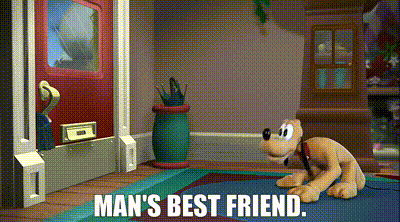
When viewing this film as a product of its format, it is key to note that this human-animal relationship of pet-keeping has been channelled through animal characters in other animations such as with Mickey Mouse (a human-like mouse character) and his dog Pluto, and so is easily recognised in The Good Dinosaur as embodying this companionship. Due to the artistic medium of animation being visually distinguished from reality, subversions such as this can occur without questioning from the viewer, allowing for diverse representations of human-animal relations such as in The Good Dinosaur.
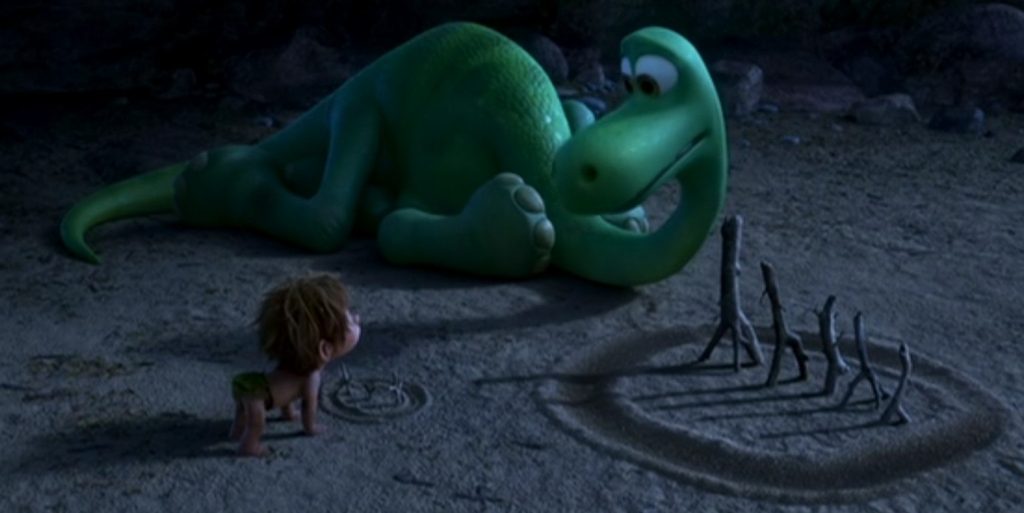
A prime scene in the film is when the two characters share a moment of mutual understanding which reflects the bonding between them. This is shown in the two-shot above which includes Arlo and Spot, with the inclusion of both of them on screen reflecting their increasing closeness. This scene begins with Arlo positioning sticks in the ground to represent his family and then drawing a circle in the dirt surrounding them to represent their bond, as shown through the mise-en-scene of the sticks standing on the ground with a circle around them. Initially, Arlo expresses doubt over Spot’s understanding of this (just as a human would not believe that a dog could interpret meaning), as shown through his dialogue “you don’t understand” which explicitly references this thought. However, as shown through the mise-en-scene of the shot above, Spot remodels Arlo’s creation to show his own family. This shared understanding reflects the human-animal relationship of petkeeping as complex as it portrays the idea that pets can understand owners even though they are unable to access a means of communication. Despite this being a common idea explored in films, (for example, Enzo in The Art of Racing in the Rain) the pet in this case is unable to communicate verbally when often in films which deal with this idea the dog’s thoughts are reflected through a narrative voice. Also, the fact that the pet in this film is the zoomorphic human is unique as in this exploration of animal’s minds this character is usually a biological dog/animal.

The pinnacle of this scene is when Spot buries his sticks that presumably represent his parents, just as human bodies are buried after death. After this, Arlo mirrors this action as he buries the stick that represents his father, which draws a striking parallel between the sticks in the ground and graveyards. This brings the bond between Spot and Arlo closer and expands on their relationships further than just merely a petkeeping relationship as they are now positioned as a pair of young orphaned creatures whose shared experiences allow for them to gain empathy for each other’s situations. Furthermore, the low lighting of this scene which includes dull grey tones contrasts with the usual bright blue and green colours of landscapes in the film. These tones reinforce the melancholy reality of their situation of losing parents as low lighting such as this is often mimicked to resemble sadness. Yet, it also embodies the dark colours of a gravestone which again emulates a graveyard and reinforces the passing of their parents.
It is this expansion of shared experience beyond the stereotypical animal role in the human-animal relationship of petkeeping that makes the audience favour their companionship even more. Also, the trope of an orphaned child who navigates life is adapted to strengthen this bond between the characters. Through having animals who experience being orphaned, the notion of shared emotions and situations is reinforced as it suggests that thoughts and feelings expand beyond the human species. Therefore, in this scene this film suggests that animals in all human-animal interactions should be treated humanely and be allowed access to the freedoms that humans have. This is because they could have similar thought processes to humans and have empathy for species outside of their own.
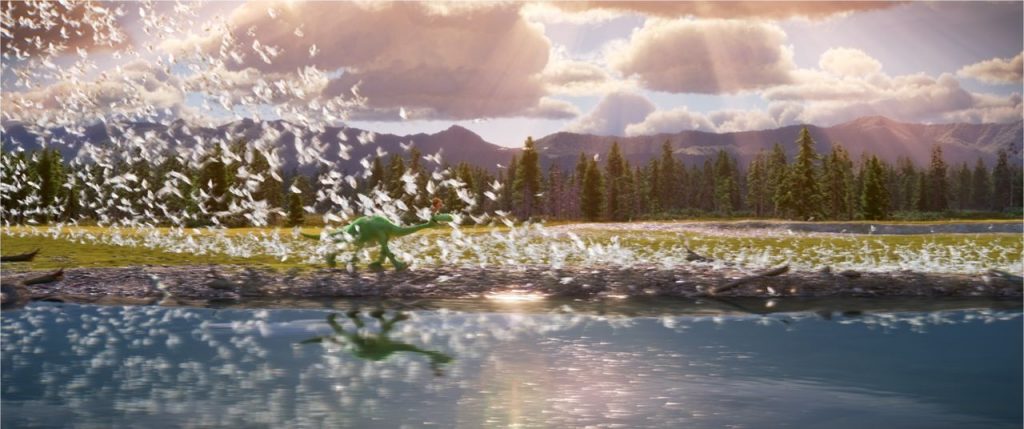
As encapsulated by the scene where Arlo and Spot run through the birds by the river, the film’s depiction of free animals is used to charge the film with a powerful meaning about the ethics surrounding petkeeping and the entrapment of animals generally. As shown in the image above, both the anthropomorphic dinosaur and the dog-like human are free to roam in the wild, as represented by the mise-en-scene which includes the trees, clouds, river and grass. This embodiment of a wild habitat is indicative of cinematographer Sharon Calahan’s choice to set the film in Wyoming as this area is known for its large national parks and is visually stunning. Accordingly, this encapsulation of the enchanting nature of the outdoors reinforces the decision to emphasise the privilege that comes with having the agency to explore it.
This beauty of the outdoors is paralleled with the loud extra-diegetic music of an excerpt from an instrumental piece called ‘Run With The Herd’ (see link to the left) which increases as they run through the birds. The build-up of the music in the scene reflects not only the freedom of the characters but their ultimate unison as they have just helped the other dinosaurs find the herd of Bison. The only other sound from the scene comes from the intra-diegetic laughter from Arlo and the howling from the two characters, promoting a sense of euphoric togetherness in their pet and owner relationship. The inclusion of birds within the mise-en-scene also points to the idea that animals should have freedom as they act as symbols of liberation due to their capability to freely roam the world. This parallels the unrestricted nature of Arlo and Spot as despite Spot being characterised as a dog (and therefore would be restricted by a collar and lead whilst outdoors) he does not have these oppressive tools and so is free.
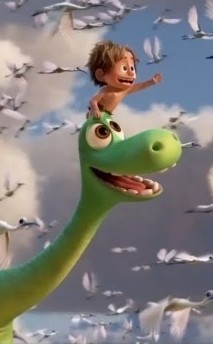
Furthermore, the incredible lighting (which appears to seep through the clouds and beam down on the characters whilst reflecting off of the river) successfully represents the beauty of nature and the outdoors as the gleaming light, which is difficult to capture in real-life, is visually beautiful. Perhaps whilst presenting the idea that animals deserve freedom, this lighting reflects the human-animal relationship of petkeeping as transparent and charming as the light exposes their happy faces and lights the path ahead for them and their journey.
Overall, through having a subverted relationship between an anthropomorphic dinosaur and a zoomorphic human, this film challenges preconceived notions surrounding dinosaurs and animals generally. These misconceptions and stereotypes include the idea that animals do not experience emotions or have individual characteristics and that dinosaurs are terrifying and predatory. Furthermore, through employing the trope of “man’s best friend” the bond between a pet and owner is explored, with the loyalty of the dog-like character mirroring that of dogs in the real world.
By subverting the conventional positions in the relationship between human and animal, this film offers the audience a new perspective on animal issues as it gives the audience a chance to view these relationships from a different perspective. In positioning the viewer in such a way, the film’s key moral message surrounding the unethical treatment of animals in petkeeping and, more broadly, animals whose agency to roam freely outdoors is restricted, is explored. This exploration of questions surrounding the morality of petkeeping is uncommon in films, as they often explore practices like zookeeping and animal testing.
References:
Annaud, Jean, J. dir., The Bear (Price Entertainment, 1988)
Behind The Lens Online, “Interview Exclusives” with Sharon Calahan, Cinematographer, THE GOOD DINOSAUR, Youtube, 18 November 2015, [accessed 2 November 2021]
Brooklyn Nine-Nine, E4, 10 January 2019, [10 January 2021]
Curtis, Simon, dir., The Art of Racing in the Rain (20th Century Fox, 2019)
Danna, Jeff, Run with the Herd | The Good Dinosaur Soundtrack | Mychael Danna & Jeff Danna, Youtube, 19 January 2018, [accessed 5 December 2021]
Disney UK, THE GOOD DINOSAUR | Trailer UK | Official Disney UK, Online interview, Youtube, 2 June 2015, [accessed 2 November 2021]
Frankel, David, dir., Marley and Me (20th Century Fox, 2008)
Hill, Eric, Where’s Spot? 22nd edn (London: Penguin Books, 2009)
O’Callaghan, Matthew, dir., Mickey’s Twice Upon a Christmas (Walt Disney Studios, 2004)
Sohn, Peter, dir., The Good Dinosaur (Disney Pixar, 2015)
Spielberg, Steven, dir., Jurassic Park (Universal Studios, 1993)
Sturridge, Charles, dir., Lassie (Odyssey Entertainment, 2005)
Wells, Paul, The Animated Bestiary: Animals, Cartoons, and Culture., 1st ed. (Piscataway: Rutgers University Press, 2008)
Further research:
Burt, Jonathan, Animals in Film (London: Reaktion, 2002)
ScreenSlam, The Good Dinosaur: Peter Sohn Exclusive Interview | ScreenSlam, Youtube, 16 February 2016 [accessed 10 December 2021]